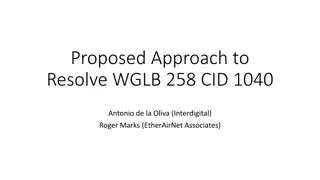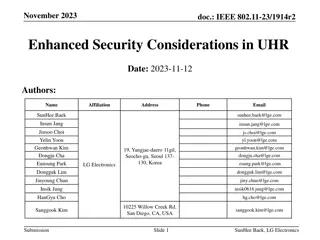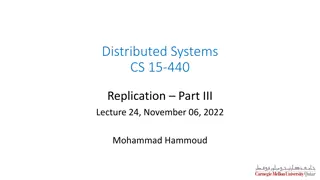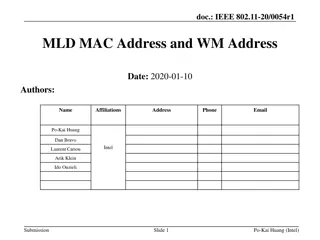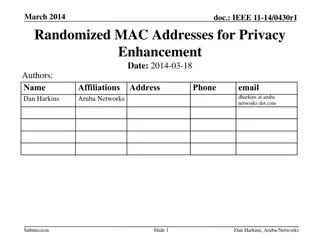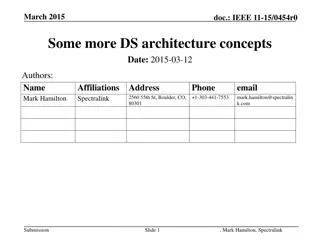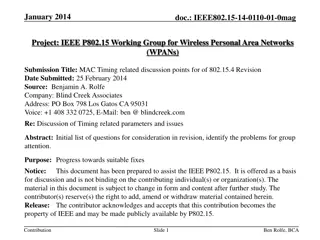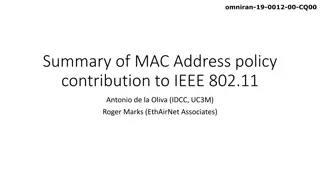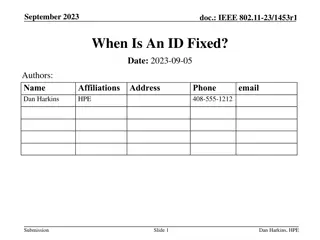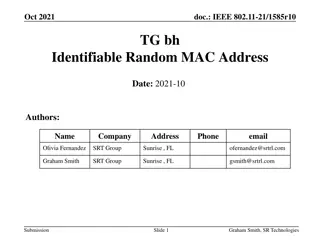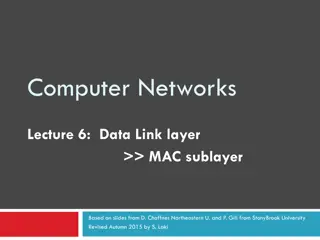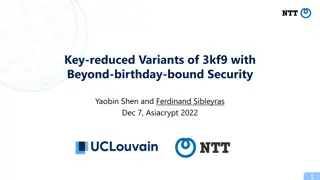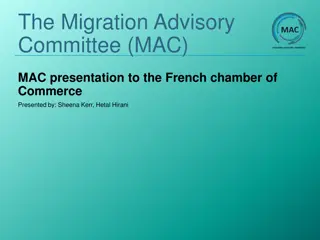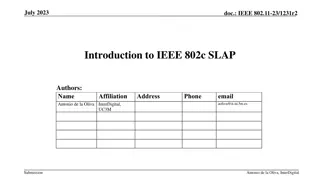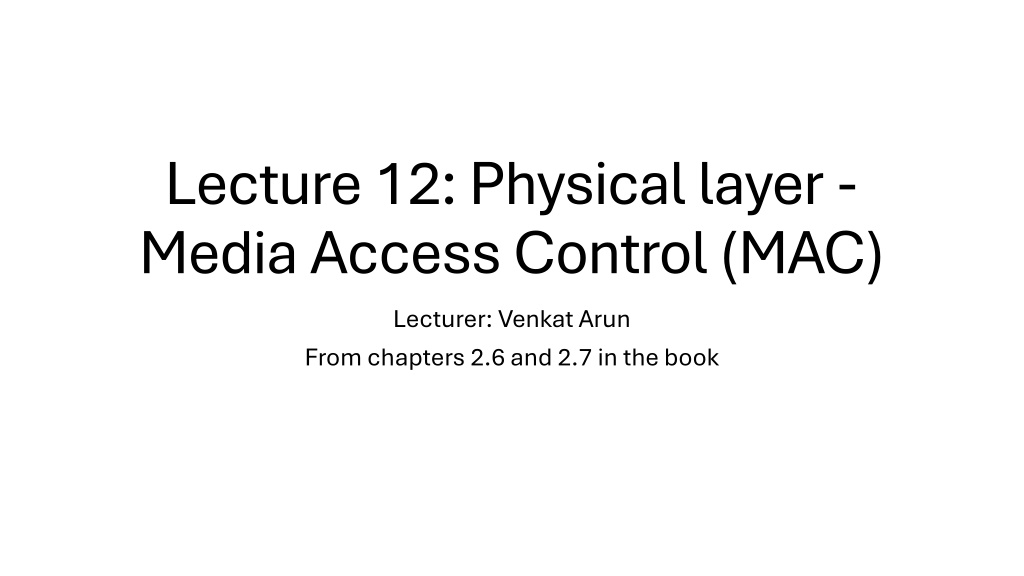
Media Access Control Techniques in Networking
Explore the concepts of sharing a medium in networking through centralized and decentralized approaches. Learn about MAC protocols and the challenges of managing communication on a shared network medium.
Download Presentation

Please find below an Image/Link to download the presentation.
The content on the website is provided AS IS for your information and personal use only. It may not be sold, licensed, or shared on other websites without obtaining consent from the author. Download presentation by click this link. If you encounter any issues during the download, it is possible that the publisher has removed the file from their server.
E N D
Presentation Transcript
Lecture 12: Physical layer - Media Access Control (MAC) Lecturer: Venkat Arun From chapters 2.6 and 2.7 in the book
Logistics Assignment 2 is due tomorrow
Sharing a medium Wireless media are always shared. Wired media can be shared too, for example if multiple nodes connect to the same piece of copper. However, it is uncommon today since it creates unnecessary contention
Sharing a medium: only one node can talk at a time Suppose A wants to transmit to B There is no wire connecting them. Thus, A must "shout". It says "The following message is intended for B: <message>" Every node within earshot listens to it. For efficiency, they only process messages that are addressed to them. o Note: they can choose to snoop on all messages. This is made useless by encryption, which we will discuss later Problem: No one else can talk while A and B are talking A B
Centralized and Decentralized ways to share a medium Decentralized Decentralized Eg. used in WiFi Nodes transmit whenever they like Sometimes two nodes transmit at once and both packets are lost There are distributed protocols to try and ensure this does not happen all the time Centralized Centralized E.g. used in cellular networks There is a dictator node(s), like the cellular base station(s), that controls all transmissions It periodically broadcasts a message telling everyone exactly who may transmit at which time slot
Point to note: How does the dictator know who wants to transmit? How does the dictator know who wants to transmit? Option 1: Be conservative and always allocate time for everyone o This was used for landline telephones, which made sense because when you are on a call, you are always talking and using the same amount of bandwidth. o Does not work for modern applications which communicate intermittently and unpredictably. o This was particularly problematic in the "dial-up internet" era where telephone lines were used to connect to the internet. You'd have to pay as if you were constantly talking on the phone even when you were just reading a website and not downloading anything o I lied a little: I lied a little: It did "frequency-division multiplexing", not time-division multiplexing, but the fundamental idea is the same Option 2: When nodes want to transmit, they send a short packet requesting time to send their longer packet o Used in cellular networks o Still needs decentralized Media Access Control protocols in case everyone wants to send this request at once
Point to note: Who is the dictator? ATT, Verizon, Who is the dictator? ATT, Verizon, TMobile government...? Do they control all transmissions in the world? government...? Do they control all transmissions in the world? TMobile, the , the As we discussed earlier, transmission rights are divided by frequency. Thanks to physics, transmissions sent on different frequencies do not mix oATT base stations are the dictators for ATT's frequencies, Verizon's base stations are the dictators for their frequencies etc. Nobody is a dictator for WiFi frequencies. In fact these frequencies are also shared with bluetooth, microwave ovens etc. This is done in a fully decentralized way
Notation: Wants to transmit Is transmitting Media Access Control: prototype 1 All the intelligence for all our prototypes will be on the sender. The receiver just passively listens to everything Carrier Sense Carrier Sense: Each node listens to see if anyone else is transmitting. If not, it starts transmitting Node 1 Node 2
Notation: Wants to transmit Is transmitting Colliding Problem with prototype 1 If two nodes want to transmit, both packets get lost... every single time Node 1 Node 2 Node 3 Both keep retrying and always collide
Notation: Wants to transmit Is transmitting Colliding Prototype 2 Same as prototype 1, but they retransmit with a smaller probability p (say 33%) Node 1 Chose to transmit Node 2 Node 3 Chose to wait Chose to transmit
Notation: Wants to transmit Is transmitting Colliding Prototype 2 Same as prototype 1, but they retransmit with a smaller probability p (say 50%) Note: collisions are possible, but will happen with probability < 1 Thus, the system will eventually succeed Chose to transmit Node 1 Chose to transmit Node 2 Node 3 Chose to transmit Chose to wait Chose to transmit
Notation: Wants to transmit Is transmitting Colliding Improvement to prototype 2 If collision occurs, stop transmitting (I'm hiding details here. See https://www.geeksforgeeks.org/c ollision-detection-csmacd/ if you are interested) Not used in WiFi because detecting collisions is hard: when I'm yelling at the top of my voice, I cannot listen Nevertheless, I will draw small collision boxes because we I am running of screen space on the slide :) Chose to transmit Node 1 Chose to transmit Node 2 Node 3 Chose to transmit Chose to wait Chose to transmit
Notation: Wants to transmit Is transmitting Colliding Improvement to prototype 2 If collision occurs, stop transmitting (I'm hiding details here. See https://www.geeksforgeeks.org/c ollision-detection-csmacd/ if you are interested) Not used in WiFi because detecting collisions is hard: when I'm yelling at the top of my voice, I cannot listen Nevertheless, I will draw small collision boxes because we I am running of screen space on the slide :) Note: Note: Collision detection was used in wired ethernet back when they still had multi-node copper wires. Chose to transmit Node 1 Chose to transmit Even though, collision detection may be possible in WiFi, it is hard to do. Plus, it leads to the hidden terminal problem anyway, which we will discuss later Node 2 Node 3 Chose to transmit Chose to wait Chose to transmit
Notation: Wants to transmit Is transmitting Colliding Problem with prototype 2 If there are more than 2 senders waiting (or more generally, 1/p senders), collisions will almost always occur If p is small, nodes wait unnecessarily even when there is no contention If it is large, then lots of collusions occur when there are > 1/p nodes Node 1 Node 2 Node 3 Node 4 Node 5
Prototype 3 This is used in WiFi and is called Carrier Sense Multiple Access/Collision Avoidance (CSMA/CA) oStart with a large p, say p = oEvery time a collision occurs, halve p Analysis: Analysis: If there are n waiting nodes, we are guaranteed to reach p < 1/n in O(log(n)) steps. If there are not a lot of waiting nodes, p remains small
We're done... almost. The hidden node problem A and C cannot hear each other, but B can hear them both Suppose A wants to talk to B. It transmits. C cannot hear A, so it transmits too. However, B cannot decipher A's packet because C keeps talking Solution: Solution: To know if a collision happened, wait for an acknowledgment from the receiver. Side benefit: helps with detecting errors that occur even without collisions
One last improvement. Then we'll be done Instead of sending full-sized packets and waiting for them to collide, send small packets first. In WiFi, this is called RTS/CTS: Request To Send/Clear To Send Anyone who hears either packet will not send for some time while the two nodes communicate
A final problem: exposed node problem Here, suppose immediate neighbors can hear each other, but others cannot If B is transmitting to A, C may incorrectly conclude that it is unsafe to send to D. However, this is not the case, since both A and D can hear without a problem In WiFi, we largely accept this inefficiency

